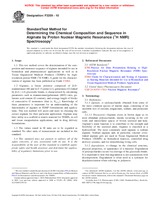We need your consent to use the individual data so that you can see information about your interests, among other things. Click "OK" to give your consent.
ASTM F2259-10
Standard Test Method for Determining the Chemical Composition and Sequence in Alginate by Proton Nuclear Magnetic Resonance (1H NMR) Spectroscopy
STANDARD published on 1.6.2010
The information about the standard:
Designation standards: ASTM F2259-10
Note: WITHDRAWN
Publication date standards: 1.6.2010
SKU: NS-53390
The number of pages: 5
Approximate weight : 15 g (0.03 lbs)
Country: American technical standard
Category: Technical standards ASTM
Annotation of standard text ASTM F2259-10 :
Keywords:
Alginates, Biomedical materials/applications, Chemical analysis--chemicals, Degradation--environmental materials/applications, Monomer sequence, Nuclear magnetic resonance (NMR) spectrometry, Pharmaceutical industry, TEMPs (tissue engineered medical products), ICS Number Code 11.120.20 (Wound dressings. Compresses), 71.040.50 (Physicochemical methods of analysis)
Additional information
| Significance and Use | ||||||
|
The composition and sequential structure of alginate determines the functionality of alginate in an application. For instance, the gelling properties of an alginate are highly dependent upon the monomer composition and sequential structure of the polymer. Gel strength will depend upon the guluronic acid content (FG) and also the average number of consecutive guluronate moieties in G-block structures (NG>1). Chemical composition and sequential structure of alginate can be determined by 1H- and 13C-nuclear magnetic resonance spectroscopy (NMR). A general description of NMR can be found in <761> of the USP24-NF19. The NMR methodology and assignments are based on data published by Grasdalen et al. (1979, 1981, 1983). , , The NMR technique has made it possible to determine the monad frequencies FM (fraction of mannuronate units) and FG (fraction of guluronate units), the four nearest neighboring (diad) frequencies FGG, FMG, FGM, FMM, and the eight next nearest neighboring (triad) frequencies FGGG, FGGM, FMGG, FMGM, FMMM, FMMG, FGMM, FGMG. Knowledge of these frequencies enables number averages of block lengths to be calculated. NG is the number average length of G-blocks, and NG>1 is the number average length of G-blocks from which singlets (-MGM-) have been excluded. Similarly, NM is the number average length of M-blocks, and NM>1 is the number average length of M-blocks from which singlets (-GMG-) have been excluded. 13C NMR must be used to determine the M-centered triads and NM>1. This test method describes only the 1H NMR analysis of alginate. Alginate can be well characterized by determining FG and NG>1. In order to obtain well-resolved NMR spectra, it is necessary to reduce the viscosity and increase the mobility of the molecules by depolymerization of alginate to a degree of polymerization of about 20 to 50. Acid hydrolysis is used to depolymerize the alginate samples. Freeze-drying, followed by dissolution in 99 % D2O, and another freeze-drying before dissolution in 99.9 % D2O yields samples with low 1H2O content. TTHA is used as a chelator to prevent traces of divalent cations to interact with alginate. While TTHA is a more effective chelator, other agents such as EDTA and citrate may be used. Such interactions may lead to line broadening and selective loss of signal intensity. Samples are analyzed at a temperature of 80 ± 1°C. Elevated sample temperature contributes to reducing sample viscosity and repositions the proton signal of residual water to an area outside that of interest. |
||||||
| 1. Scope | ||||||
|
1.1 This test method covers the determination of the composition and monomer sequence of alginate intended for use in biomedical and pharmaceutical applications as well as in Tissue Engineered Medical Products (TEMPs) by high-resolution proton NMR (1H NMR). A guide for the characterization of alginate has been published as Guide F2064. 1.2 Alginate, a linear polymer composed of β-D-mannuronate (M) and its C-5 epimer α-L-guluronate (G) linked by β-(1>4) glycosidic bonds, is characterized by calculating parameters such as mannuronate/guluronate (M/G) ratio, guluronic acid content (G-content), and average length of blocks of consecutive G monomers (that is, NG>1). Knowledge of these parameters is important for an understanding of the functionality of alginate in TEMP formulations and applications. This test method will assist end users in choosing the correct alginate for their particular application. Alginate may have utility as a scaffold or matrix material for TEMPs, in cell and tissue encapsulation applications, and in drug delivery formulations. 1.3 The values stated in SI units are to be regarded as standard. No other units of measurement are included in this standard. 1.4 This standard does not purport to address all of the safety concerns, if any, associated with its use. It is the responsibility of the user of this standard to establish appropriate safety and health practices and determine the applicability of regulatory limitations prior to use. |
||||||
| 2. Referenced Documents | ||||||
|
We recommend:
Updating of laws
Do you want to be sure about the validity of used regulations?
We offer you a solution so that you could use valid and updated legislative regulations.
Would you like to get more information? Look at this page.




 Cookies
Cookies
